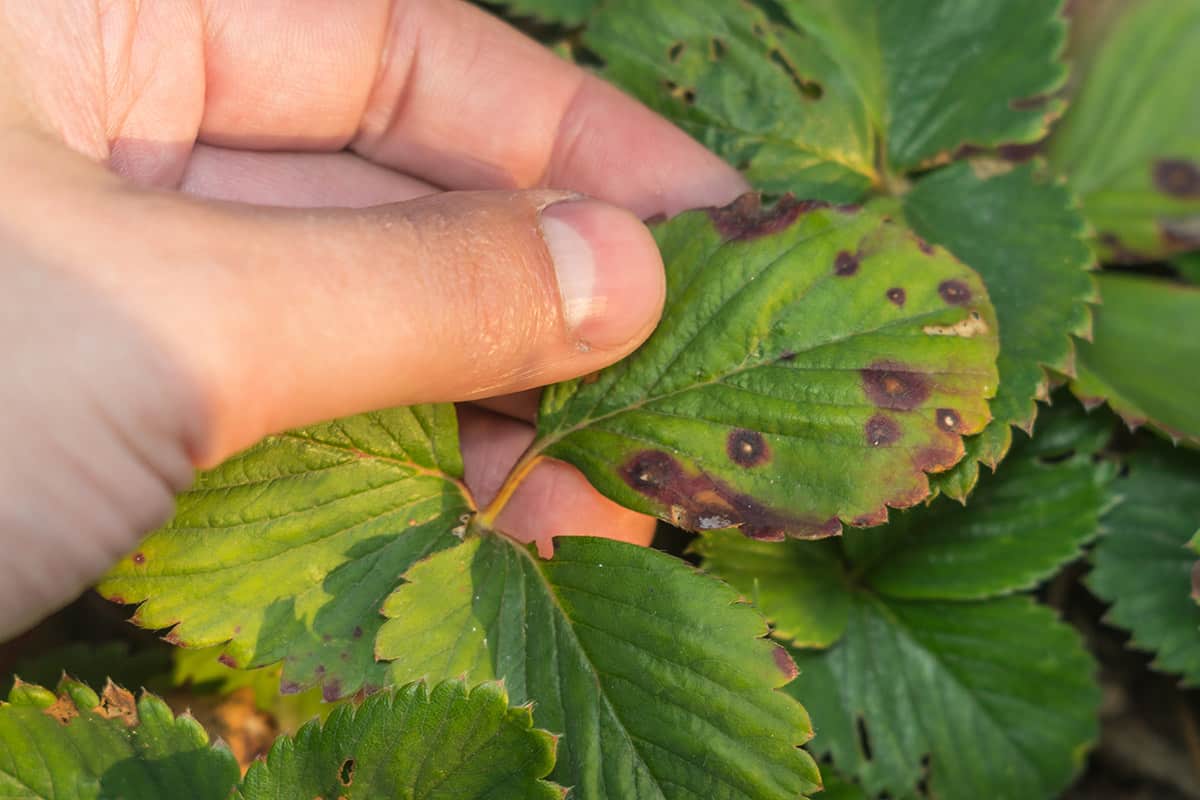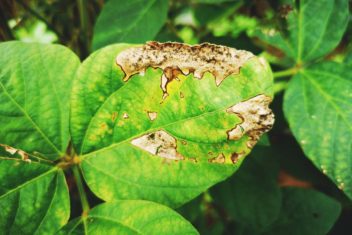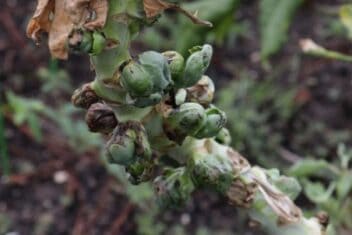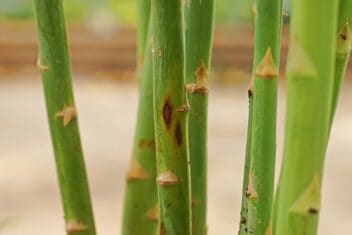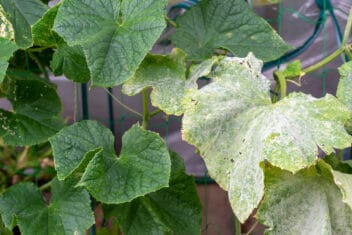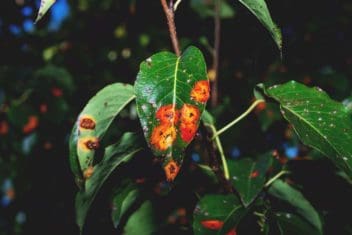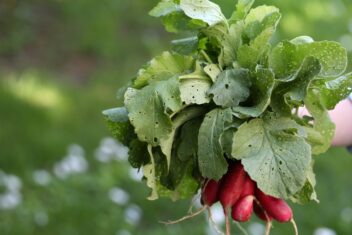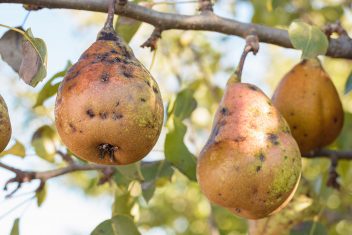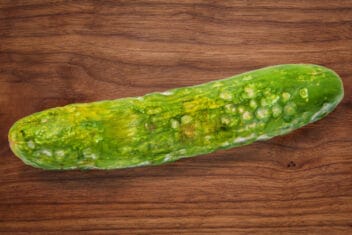Fungi, bacteria, viruses, and nematodes—oh my! These plant pathogens will undoubtedly show up in your garden eventually. Fortunately, there are ways to identify them and treat them with natural means.
Let’s take a look at some of the most insidious interlopers and how to get rid of them.
Fungi
Have you ever had to deal with a case of athlete’s foot? If you have, then you know that it was caused by a fungal infection. Well, guess what? Plants can suffer from fungal issues too, and they can wreak serious havoc if you don’t sort them out.
Potato Blight (Phytophthora infestans)
Do you remember hearing about the great Irish potato famine? That was caused by Phytophthora infestans—one of the worst plant pathogens out there.
It doesn’t just affect potatoes but can obliterate anything in the nightshade family. This includes tomatoes, eggplants, peppers, goji berries, tomatillos, and more.
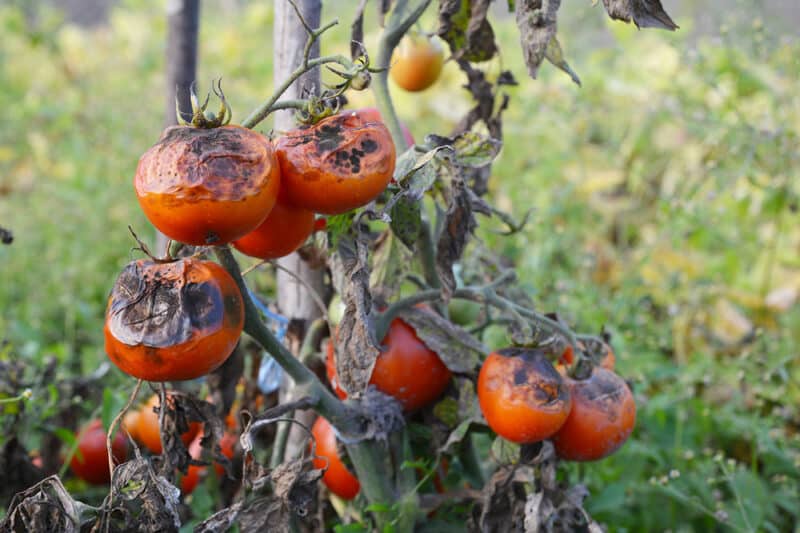
You’ll recognize this infection by the bullseye-like dark rings that appear on the plants’ leaves. If you don’t catch and treat this disease early, the infection will move down to the stems, roots, and tubers, turning them into black sludge.
If you catch it early, apply a liquid copper-based fungicide. Just follow directions on the bottle, and be diligent about treatment.
Prevention is better than cure when it comes to this blight. It thrives in hot, humid weather, so try to cultivate your nightshades in a protected locale.
Make sure to plant them in soil that drains well and doesn’t get waterlogged. If you live in a zone where summers get too humid, grow your potatoes and tomatoes in greenhouses instead.
Practice good soil care, and rotate your crops annually to keep the soil—and edible plants—healthy.
Rust
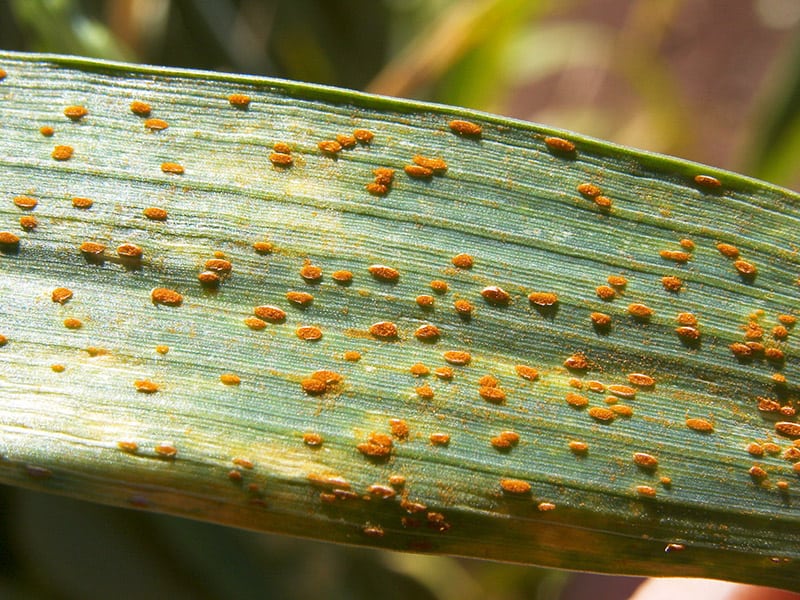
Rust blight is easy to identify because of the hue that gives it its name. Basically, it causes rust-colored pustules on the plants it infects. It also thrives in wet weather, but prefers cool temperatures rather than hot.
You’ll recognize it by the orange dots all over leaves and stems, which cause leaf drop and overall wilting.
As with potato blight, prevention is ideal here.
Rust spores thrive in moist environments and need humidity to germinate. As a result, you can thwart their efforts by reducing humidity [1].
Water at soil level rather than from overhead, so you don’t drench their leaves. Additionally, make sure that you don’t crowd your plants. Give them plenty of space so air can circulate and excess moisture can dissipate.
Although copper-based fungicides are great for treating rust as well as potato blight, you’ll need to get rid of infected plants as well. Dig them up and burn them, then treat the soil and surrounding plants with that coppery spray.
For more tips, check out our guide to dealing with rust in the garden.
Powdery Mildew
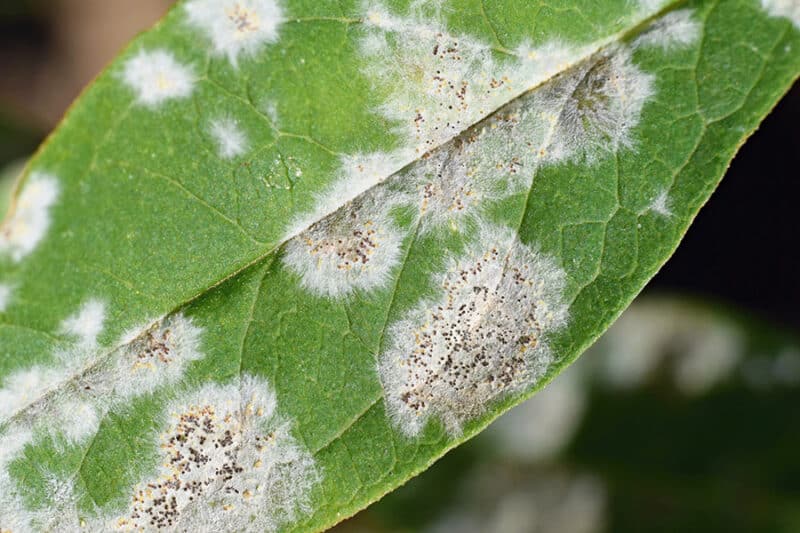
This fungal infection is a right jerk. Powdery mildew caused by a range of fungi in the Erysiphales order, such as E. cichoracearum var. These fungi like to attack all manner of different plant families.
It has annihilated my zucchini and peonies alike, nearly killed an entire patch of St. John’s wort, [2] and can be difficult to get rid of.
You’ll recognize it by its description, really. Do your plants look like you’ve dabbed them with talcum powder or corn starch? Then you’re in powdery mildew land.
You can try to prevent this issue by planting mildew-resistant varieties. Space your plants out well, don’t overwater them, and clear out debris from soil level. For example, rake and sweep away fallen leaves.
If your plants do get powdery, there are some incredibly effective natural treatments available. Some people swear by milk as a natural anti-fungal. I haven’t tried this method, but I use both garlic water and apple cider vinegar sprays to good effect.
Our guide has lots of tips and tricks to help you tackle this common disease.
Bacteria
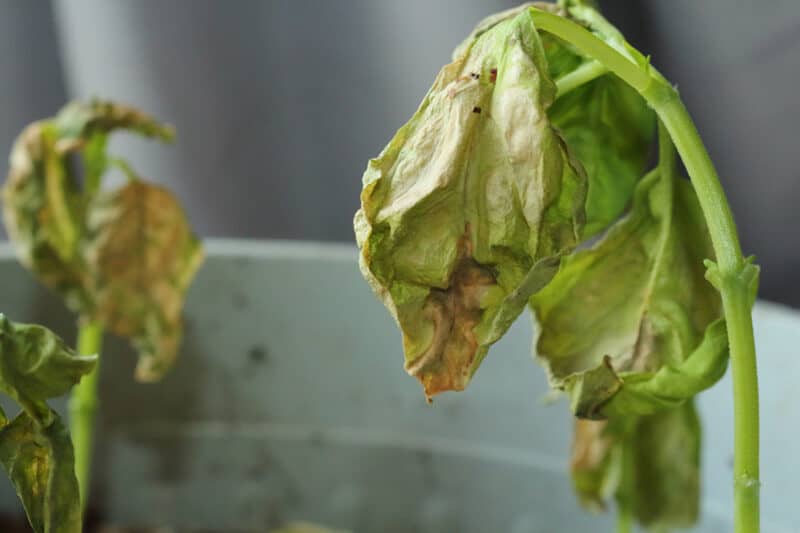
Are you familiar with verticillium wilt (Verticillium dahliae) and various leaf blights? If so, then you’ve already met a couple of the worst bacterial plant pathogens.
Although these are soil-borne, they’re generally distributed via insects. Bugs bite through stems or roots, and the bacteria in their filthy mouth holes transfer into the plants’ circulatory systems. Once there, they nestle into the little spaces between cells and sicken the entire plant [3].
Then, the leaves turn black and spotty, the stems wilt, and the plant dies.
You can take preventative measures against these plant pathogens by choosing bacteria-resistant species. Once severely infected, however, you’ll need to dig up and burn the sickly plants.
Treat surrounding plants and soil with Bordeaux mixture (made of copper sulfate and lime). Just keep in mind that these can only reduce the infection from spreading further: once plants are already diseased, they can’t be cured.
Viruses
There are a few major viruses that affect garden plants:
- Cucumber mosaic virus (a plant pathogenic virus in the family Bromoviridae)
- Brassica mosaic virus (from the family Caulimoviridae order Ortervirales)
- Tobacco mosaic virus (a single-stranded RNA species in the Tobamovirus genus)
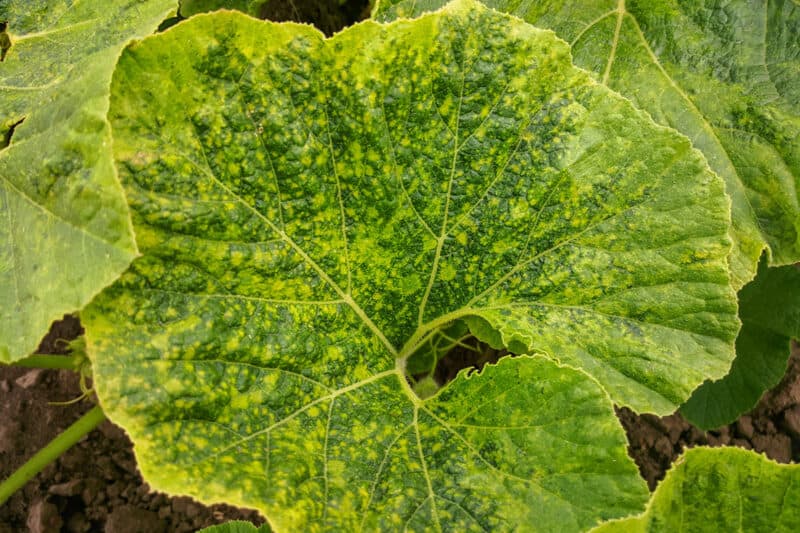
Don’t these sound fun? These plant pathogens hide inside host cells and destroy your plants from the inside out by parasitizing them.
These viruses all present as mottled discoloration on leaves’ surfaces. This can be symptomatic of different plant pathogens, but viruses can be determined by the fact that you can’t see them in soil tests (unlike nematodes, bacteria, etc.).
Once you’ve determined that your plants are affected by these mosaic viruses, you have to take drastic action. All affected plants have to be dug up and burned. Dig up several layers of soil, sterilize it all with boiling water, then dispose of it at a designated contaminated soil location.
Avoid planting anything in that area for a year. Since these mosaic viruses are mostly spread by aphids, treat the entire area with natural insecticides that target those insects, such as diatomaceous earth.
Since there are no effective cures for viral infections, try to avoid/prevent pathogens in the future. Create well-draining raised beds, and fill them with virus-free soil. Choose virus-resistant cultivars, and keep a diligent eye on your garden so you can leap into action as needed.
Nematodes
Are you already familiar with nematodes? If not, brace yourself.
These microscopic insects are also known as roundworms and love to feed on an assortment of garden plants [4]. You need a microscope to see them, and if you could see any in your soil, they’ll look similar to regular worms with long, squiggly bodies.
These jerks can harm both roots and leafy plants, as they can worm (hahah) their way into just about any plant part. Since they’re soil-borne parasites, roots are naturally the easiest prey for them.
They’ll attack carrots, beets, potatoes, and other root vegetables with glee. That said, they also really like nightshade roots and will gnaw on pepper, tomato, and eggplant roots too.
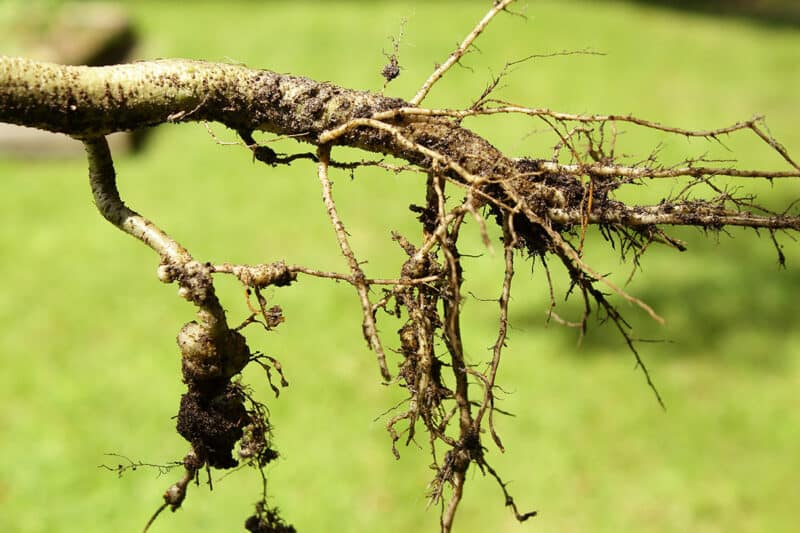
They happen to like grains and greens too, of course. Nematodes will commonly attack rye, wheat, alfalfa, and oats and take on lettuces and even flowers.
Not all nematodes are bad, however. Our guide gives you all the details.
How to Identify Nematode Infestations:
Yeah, here’s the problem: nematode damage can look like a ton of different plant issues.
You might get shriveled leaves (or leaf drop), malformed flowers, or drooping stems, for example. These could be attributed to over or under-watering, nutrient deficiency, etc.
As a result, it’s a good idea to get yourself a microscope and check your soil just in case. You can also have your soil tested. If you find nematodes, then you can treat them accordingly.
Alternatively, if you don’t, you can rule them out as a possible damaging factor and take other action to help your plants.
How to Sort Out Harmful Parasitic Nematode Infestations
The main problem with nematodes isn’t that they themselves cause a great deal of plant damage. Instead, their bites leave the plant vulnerable to a host of different diseases and infections.
Think of it as a bad cut on a human body. The cut itself might not cause structural damage, but if it gets badly infected, there’s a problem.
Although there aren’t any products that you can smack down into the soil to get rid of these plant pathogens, you can treat the soil. You can also preempt potential harm with some strategic growing.
- Preempt with compost. Make sure to dig a lot of well-aged compost into your soil before planting. The nematodes will be distracted by the tasty organic nom-noms and will be less likely to munch on your plants.
- Choose cool-weather crops. Since these little jerks are inactive in colder weather, aim to do most of your growing in the spring and fall. They also seem to dislike brassicas, so there’s a win-win here. Since brassicas prefer cool weather, plant plenty of arugula, cabbage, mustard, collards, and broccoli.
- Select nematode-resistant varieties. You’ll see this on the care label when you buy seeds or seedlings.
- Heat things up. Nematodes really don’t like heat much, so you can cook them out and away from your grow beds. Remove your plants, lay down some thick plastic sheeting, and let the sun bake the jerks. This works best during the hottest part of the summer.
- Dig up your garden at the end of the season, and turn the soil over. By doing this, you starve nematodes of their food source. Then, by tilling the soil several inches deep, you’ll expose these worms to the sun, thereby killing them.
Prevention and Avoidance = Fewer Plant Pathogens
It’s important to remember that plant pathogens are inevitable. Much as we would all love to live in a world where no living thing was ever stricken with an illness or infection, that’s not going to happen.
Prevention is a lot more helpful than any cure, of course. Fortunately, you can take some preventative measures to keep these issues at bay.
For one thing, treat your garden like a sacred space. Have a set of clothes and boots that you only wear when gardening. Change into them just before you work out there, and clean them regularly. Don’t let random people into your garden, and don’t allow any domestic animals in there.
Should you have visitors, make sure they change into a sterile set of clothes before entering the garden area.
This might seem extreme, but I’ve seen entire crops obliterated because mites hitched a ride on a neighbor’s dog and jumped onto healthy plants during a friendly visit.
Keep your tools clean, be diligent about checking your plants regularly, and keep natural treatments at hand just in case. Acting quickly can mean the difference between saving your garden and having to torch it all and start again from scratch.
References:
- White Pine Blister Rust: O. C. Maloy, https://www.apsnet.org/edcenter/intropp/lessons/fungi/Basidiomycetes/Pages/WhitePine.aspx, 2003.
- Treating Erysiphae cichoracearum var. cichoracearum on St. John’s wort in Serbia: Pavlović, Stojanović, Starović, Institute for Plant Protection and Environment, Belgrade: plantarum.izbis.bg.ac.rs:123456789/114, 2009
- Bacterial Diseases of Plants: Williams, Boehm, and Peduto Hand, Department of Plant Pathology, Ohio State University, Agriculture and Natural Resources, 2017
- Introduction to Plant-Parasitic Nematodes: Lambert, K. and S. Bekal, The Plant Health Instructor. DOI: 10.1094/PHI-I-2002-1218-01, 2002.
